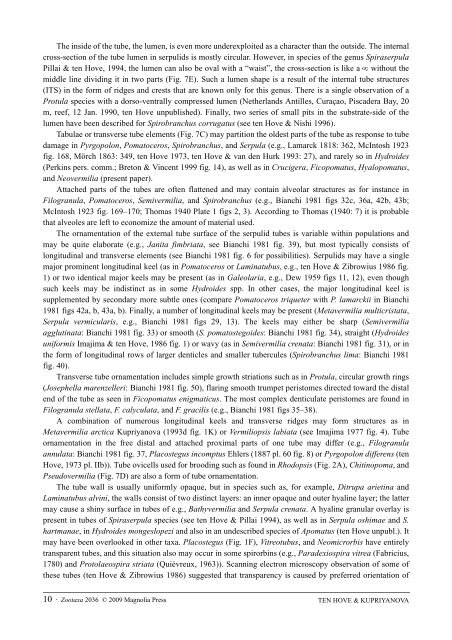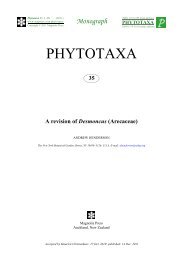Zootaxa, Taxonomy of Serpulidae (Annelida ... - Magnolia Press
Zootaxa, Taxonomy of Serpulidae (Annelida ... - Magnolia Press
Zootaxa, Taxonomy of Serpulidae (Annelida ... - Magnolia Press
You also want an ePaper? Increase the reach of your titles
YUMPU automatically turns print PDFs into web optimized ePapers that Google loves.
The inside <strong>of</strong> the tube, the lumen, is even more underexploited as a character than the outside. The internal<br />
cross-section <strong>of</strong> the tube lumen in serpulids is mostly circular. However, in species <strong>of</strong> the genus Spiraserpula<br />
Pillai & ten Hove, 1994, the lumen can also be oval with a “waist”, the cross-section is like a ∞ without the<br />
middle line dividing it in two parts (Fig. 7E). Such a lumen shape is a result <strong>of</strong> the internal tube structures<br />
(ITS) in the form <strong>of</strong> ridges and crests that are known only for this genus. There is a single observation <strong>of</strong> a<br />
Protula species with a dorso-ventrally compressed lumen (Netherlands Antilles, Curaçao, Piscadera Bay, 20<br />
m, reef, 12 Jan. 1990, ten Hove unpublished). Finally, two series <strong>of</strong> small pits in the substrate-side <strong>of</strong> the<br />
lumen have been described for Spirobranchus corrugatus (see ten Hove & Nishi 1996).<br />
Tabulae or transverse tube elements (Fig. 7C) may partition the oldest parts <strong>of</strong> the tube as response to tube<br />
damage in Pyrgopolon, Pomatoceros, Spirobranchus, and Serpula (e.g., Lamarck 1818: 362, McIntosh 1923<br />
fig. 168, Mörch 1863: 349, ten Hove 1973, ten Hove & van den Hurk 1993: 27), and rarely so in Hydroides<br />
(Perkins pers. comm.; Breton & Vincent 1999 fig. 14), as well as in Crucigera, Ficopomatus, Hyalopomatus,<br />
and Neovermilia (present paper).<br />
Attached parts <strong>of</strong> the tubes are <strong>of</strong>ten flattened and may contain alveolar structures as for instance in<br />
Filogranula, Pomatoceros, Semivermilia, and Spirobranchus (e.g., Bianchi 1981 figs 32c, 36a, 42b, 43b;<br />
McIntosh 1923 fig. 169–170; Thomas 1940 Plate 1 figs 2, 3). According to Thomas (1940: 7) it is probable<br />
that alveoles are left to economize the amount <strong>of</strong> material used.<br />
The ornamentation <strong>of</strong> the external tube surface <strong>of</strong> the serpulid tubes is variable within populations and<br />
may be quite elaborate (e.g., Janita fimbriata, see Bianchi 1981 fig. 39), but most typically consists <strong>of</strong><br />
longitudinal and transverse elements (see Bianchi 1981 fig. 6 for possibilities). Serpulids may have a single<br />
major prominent longitudinal keel (as in Pomatoceros or Laminatubus, e.g., ten Hove & Zibrowius 1986 fig.<br />
1) or two identical major keels may be present (as in Galeolaria, e.g., Dew 1959 figs 11, 12), even though<br />
such keels may be indistinct as in some Hydroides spp. In other cases, the major longitudinal keel is<br />
supplemented by secondary more subtle ones (compare Pomatoceros triqueter with P. lamarckii in Bianchi<br />
1981 figs 42a, b, 43a, b). Finally, a number <strong>of</strong> longitudinal keels may be present (Metavermilia multicristata,<br />
Serpula vermicularis, e.g., Bianchi 1981 figs 29, 13). The keels may either be sharp (Semivermilia<br />
agglutinata: Bianchi 1981 fig. 33) or smooth (S. pomatostegoides: Bianchi 1981 fig. 34), straight (Hydroides<br />
uniformis Imajima & ten Hove, 1986 fig. 1) or wavy (as in Semivermilia crenata: Bianchi 1981 fig. 31), or in<br />
the form <strong>of</strong> longitudinal rows <strong>of</strong> larger denticles and smaller tubercules (Spirobranchus lima: Bianchi 1981<br />
fig. 40).<br />
Transverse tube ornamentation includes simple growth striations such as in Protula, circular growth rings<br />
(Josephella marenzelleri: Bianchi 1981 fig. 50), flaring smooth trumpet peristomes directed toward the distal<br />
end <strong>of</strong> the tube as seen in Ficopomatus enigmaticus. The most complex denticulate peristomes are found in<br />
Filogranula stellata, F. calyculata, and F. gracilis (e.g., Bianchi 1981 figs 35–38).<br />
A combination <strong>of</strong> numerous longitudinal keels and transverse ridges may form structures as in<br />
Metavermilia arctica Kupriyanova (1993d fig. 1K) or Vermiliopsis labiata (see Imajima 1977 fig. 4). Tube<br />
ornamentation in the free distal and attached proximal parts <strong>of</strong> one tube may differ (e.g., Filogranula<br />
annulata: Bianchi 1981 fig. 37, Placostegus incomptus Ehlers (1887 pl. 60 fig. 8) or Pyrgopolon differens (ten<br />
Hove, 1973 pl. IIb)). Tube ovicells used for brooding such as found in Rhodopsis (Fig. 2A), Chitinopoma, and<br />
Pseudovermilia (Fig. 7D) are also a form <strong>of</strong> tube ornamentation.<br />
The tube wall is usually uniformly opaque, but in species such as, for example, Ditrupa arietina and<br />
Laminatubus alvini, the walls consist <strong>of</strong> two distinct layers: an inner opaque and outer hyaline layer; the latter<br />
may cause a shiny surface in tubes <strong>of</strong> e.g., Bathyvermilia and Serpula crenata. A hyaline granular overlay is<br />
present in tubes <strong>of</strong> Spiraserpula species (see ten Hove & Pillai 1994), as well as in Serpula oshimae and S.<br />
hartmanae, in Hydroides mongeslopezi and also in an undescribed species <strong>of</strong> Apomatus (ten Hove unpubl.). It<br />
may have been overlooked in other taxa. Placostegus (Fig. 1F), Vitreotubus, and Neomicrorbis have entirely<br />
transparent tubes, and this situation also may occur in some spirorbins (e.g., Paradexiospira vitrea (Fabricius,<br />
1780) and Protolaeospira striata (Quiévreux, 1963)). Scanning electron microscopy observation <strong>of</strong> some <strong>of</strong><br />
these tubes (ten Hove & Zibrowius 1986) suggested that transparency is caused by preferred orientation <strong>of</strong><br />
10 · <strong>Zootaxa</strong> 2036 © 2009 <strong>Magnolia</strong> <strong>Press</strong><br />
TEN HOVE & KUPRIYANOVA
















